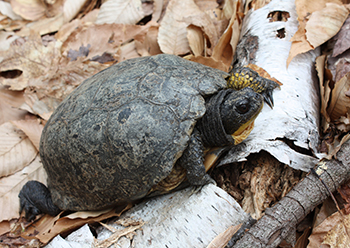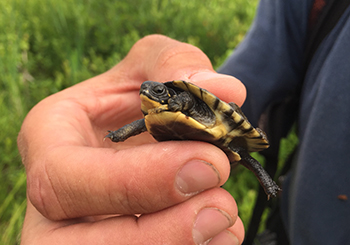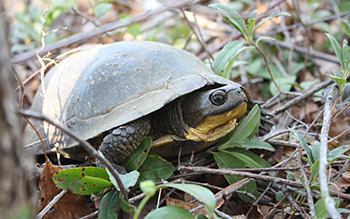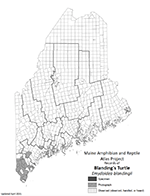Home → Fish & Wildlife → Wildlife → Species Information → Reptiles & Amphibians → Blanding’s Turtle
Blanding’s Turtle
Emydoidea blandingii
Please report your sighting of this Endangered species as soon as possible.
On this page:

Photo: Trevor Persons
Distinguishing Characteristics

Photo: Trevor Persons
- Medium-sized to large, carapace approximately 7 to 9 inches in length
- Smooth, helmet-shaped carapace (upper part of shell) is brownish-black to black with abundant cream or light tan flecks and streaks
- Conspicuous bright yellow chin and throat
- Plastron (bottom part of shell) is partially hinged; yellowish with large black blotches
Status and Distribution in Maine
- State Endangered; Species of Greatest Conservation Need
- Rare
- Southern region only
Habitat

Photo: Trevor Persons
- Primarily aquatic, found in vernal pools, marshes, scrub-shrub swamps, streams, and ponds
- Habitats with dense emergent vegetation and basking sites such as logs or sphagnum-covered hummocks
- Spends period of summer inactive under leaf litter in forested areas near wetlands
Diet
- Omnivorous, diet includes plants, berries, fish, larval amphibians, insects, mollusks, slugs, and earthworms
- Makes annual trips to vernal pools to feed on breeding amphibians
Seasonal Changes
- Hibernates at the bottom of wetlands such as ponds, shrub swamps, and vernal pools
Natural History Notes
- Can travel great distances, with some radio-tagged turtles moving up to 1.2 miles between wetlands; for this reason, threatened by habitat fragmentation from roads
- Sometimes known as a “semi-box turtle” because of its partial plastron hinge
Share Your Sighting
Please report this Endangered species as soon as possible!
There is much still to learn about the distribution and ecology of Maine's herpetofauna, and we encourage members of the public to share their photo-documented observations as part of the Maine Amphibian & Reptile Atlas Project (MARAP).
Submit your reptile or amphibian observation online
No service? No problem. Click here to download the survey to your device while connected, then take offline to collect observations from anywhere. Tip: The survey works best on Google Chrome and Safari.
Thank you for doing your part to help conserve Maine's reptiles and amphibians. For more information, please contact kevin.ryan@maine.gov.
